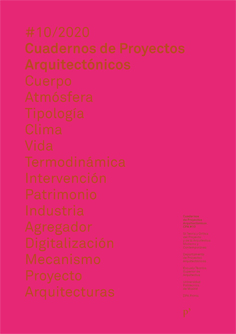The hybrid building concept. Topological characterisation as a project resource
DOI:
https://doi.org/10.20868/cpa.2020.10.4576Palabras clave:
Hybrid, Mixed-use, Topology, Megastructure, BignessResumen
Abstract
The hybrid building concept has been used since the end of the 20th century to describe architectures with multiple interrelated uses. The simplicity of the current definition has led to confusion among the hybrid and other typologies, such as social condensers, architectural megastructures and skyscrapers. In addition to this controversy, we must take note the contemporary theories that reject the multifunctional characterisation of hybrid architecture. Through a comparative analysis of functional character (use), typology (shape), topology (system) and semantics (verbal definition), the intention is to clarify differences between contemporary hybrid buildings and other typologies and architectural classifications. It will provide an updated definition of the hybrid building concept and will verify the topological characterisation of contemporary hybrid buildings. Beyond achieving a categorical definition, the idea is to evince a design method and present architectural hybridisation as a strategy or project tool.
Descargas
Referencias
ANGÉLIL, Marc y Anna Klingmann. “Hybrid Morphologies - Infrastructure, Architecture, Landscape.” Daidalos 73 (1999): 16–25.
ARISTÓTELES. “Libro II.” En Reproducción de Los Animales, 120–84. Madrid: Gredos, 1994.
BANHAM, Reyner. Megaestructuras. Futuro Urbano Del Pasado Reciente. Traducido por Ramón Font. Barcelona: Gustavo Gili, 1978.
BENEVOLO, Leonardo. Historia de La Arquitectura Moderna. Traducido por María Castaldi y Jesús Fernández Santos. Barcelona: Gustavo Gili, 1977
FAIDEN, Marcelo. “Los Bajos de Los Edificios Altos.” Tesis doctoral, Universitat Politècnica de Catalunya, 2015
FENTON, Joseph. “Hybrid Buildings.” Pamphlet Architecture 11 (Nueva York: Princeton Architectural Press, 1985).
FERNÁNDEZ PER, Aurora. “Hybrid Versus Social Condenser.” En Hybrids III : Híbridos Residenciales = Residential Mixed-Use Buildings, 4–13. Vitoria: a+t ediciones, 2009.
GAUSA, Manuel, Vicente Guallart, Willy Müller, José Morales Sánchez y Fernando Porras. Diccionario Metápolis de Arquitectura Avanzada. Barcelona: Actar, 2001.
GONZÁLEZ DE CANALES, Francisco. “Beyond Bigness. Sobre las Implicaciones Críticas de una Lectura Formal de la Obra de Rem Koolhaas (1987-1993).” Proyecto, Progreso, Arquitectura 10 (2014): 32–47. https:// doi.org/http://dx.doi. org/10.12795/ppa.2014. i10.02.
HADDADI, Salvador. “Edificios Híbridos como Sistemas Vivos. El Programa Arquitectónico como Cambio de Forma de Vida.” En De Forma Et Vita. La Arquitectura En La Relación de Lo Vivo Con Lo No Vivo, 217–31. Sevilla: Athenaica, 2020
HOLL, Steven. “Bridge of Houses.” Pamphlet Architecture 7 (Julio 1981). “Bridges.” Pamphlet Architecture 1 (Diciembre 1977). “Porosity.” En Parallax, 302–31. Basel, Boston, Berlin: Birkhäuser Architecture, 2000. “The Alphabetical City.” Pamphlet Architecture 5 (Marzo 1980): 1–71.
KAIJIMA, Momoyo y Junzo Kuroda. Made in Tokyo: Guide Book. Tokyo: Kajima Institute Publishing, 2001.
KOOLHAAS, Rem. Content. Colonia: Taschen, 2002. Delirio de Nueva York. Traducido por Jorge Sainz. Barcelona: Gustavo Gili, 2004. “Junkspace.” October 100 (2002): 175–90.
KOOLHAAS, Rem, Hans Werlemann y Bruce Mau. S, M, L, XL. New York: The Monacelli Press, 1995
KOPP, Anatole. Ville et Révolution: Architecture et Urbanisme Soviétiques Des Années Vingt. Paris: Anthropos, 1967.
MAAS, inny, Jacob Van Rijs, Nathalie de Vries, Luis Moreno Mansilla y Emilio Tuñon. “El Espacio Del Optimismo= The Space of Optimism.” El Croquis 86 (1997): 6–26.
MAKI, Fumihiko. “Investigation in Collective Form.” The School of Architecture. Washington University 2 (1964): 8–13.
MATHEWS, Stanley. From Agit - Prop to Free Space: The Architecture of Cedric Price. London: Black Dog, 2007.
MESTRE MARTÍNEZ, Nieves. “Híbrido: Entre La Disidencia y La Ecología= Hybrid: Between Dissidence and Ecology.” ZARCH: Journal of Interdisciplinary Studies in Architecture and Urbanism 3 (2014): 158–67. https://zarch.unizar.es/ images/Descargas/PDF/ Revista03/0311-Nieves Mestre.pdf.
MOZAS, Javier. “Usos Mezclados. Un Recorrido Histórico= Mixed Uses. A Historical Overview.” En Hybrids II: Híbridos Horizontales= Low-Rise Mixed Use Buildings, 4–25. Vitoria: a+t ediciones, 2008.
MUSIATOWICZ, Martin. “Vigor Híbrido y El Arte de Mezclar= Hibrid Vigour and the Art of Mixing.” En Hybrids I: Híbridos Verticales= High-Rise Mixed-Use Buildings, 4–17. Vitoria: a+t ediciones, 2008.
MVRDV. Farmax. Excusions on Density. Rotterdam: 010 Publishers, 1998.
NICOLAU, Alberto. “Figuración Retórica En La Obra de Rem Koolhaas.” Cuadernos de Proyectos Arquitectónicos 8 (2014): 72–89. http://polired.upm. es/index.php/proyectos_ arquitectonicos/article/ view/3976.
RAE. “Híbrido, Da,” 2019. https://dle.rae.es/híbrido.
SANTACANA, Amadeu. “El Acontecimiento En Un Mundo Como Yuxtaposición.” Tesis doctoral, Universidad Politécnica de Cataluña, 2013.
SANTOS-FERNANDES PINTO DE FREITAS, Rita. “Arquitectura Híbrida_ context, Escala, Ordre= Hybrid Archtecture_ context, Scale, Order.” Tesis doctoral, Universitat Politècnica de Catalunya, 2011.
WILCOXON, Ralph. Council of Planning Librarians Exchange Bibliography, No 66. Illinois: Monticello, 1968.
WILKEN, Rowan. “Calculated Uncertainty: Computers, Chance Encounters, and “Community” in the Work of Cedric Price.” Transformations Journal of Media and Culture, no. 14 (2007): 1–14.
Descargas
Publicado
Número
Sección
Licencia
1. Los autores conservan los derechos de autor y garantizan a la revista el derecho de una Licencia Creative Commons Atribución-NoComercial-SinDerivar 4.0 Internacional que permite a otros compartir el trabajo con un reconocimiento de la autoría.
2. Los autores pueden establecer por separado acuerdos adicionales para la distribución no exclusiva de la versión de la obra publicada en la revista (por ejemplo, situarlo en un repositorio institucional o publicarlo en un libro).













